#Hindu deity Ganesha
Explore tagged Tumblr posts
Text
Interfaith Harmony: Ganesha, the Universal Remover of Obstacles
There is an ancient story, older than memory, that speaks of a gentle presence who stands at the threshold of each journey. He is called Ganesha, the remover of obstacles. In Hindu tradition, he is worshipped as a friend and guardian of beginnings, an embodiment of wisdom and gentle strength. His form is unmistakable—an elephant head, eyes deep with understanding, a body both round and rooted, as…
#awakening journey#cultural bridges#divine understanding#Ganesha#Ganesha invocation#highest good protocol#Hindu deity Ganesha#inner clarity#Inner peace#inner strength#interfaith connections#Interfaith harmony#mindfulness in Hinduism#overcoming ego#path to God#peace within#personal transformation#religious unity#remover of obstacles#Self-awareness#Spiritual Clarity#spiritual cooperation#spiritual symbolism#spiritual wisdom#transcending fear#unity in diversity#unity in spirit
1 note
·
View note
Text
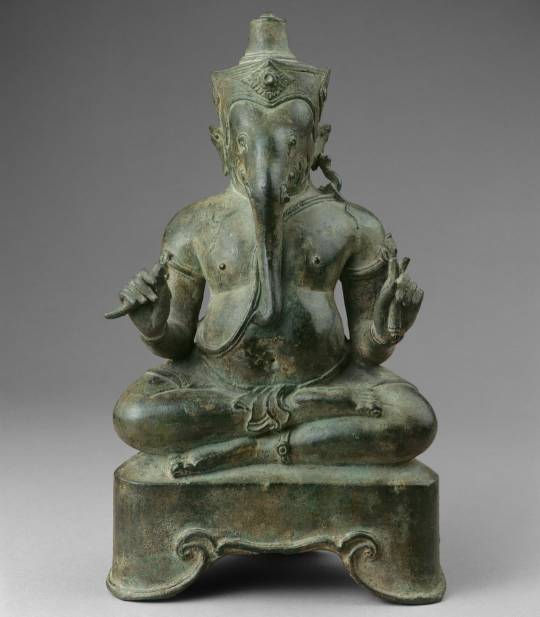
Bronze sculpture of Ganesha. Thailand, 15th century
82 notes
·
View notes
Note
Remember when you said the evil ghosts might not join our abdaar, cuz of the "No Negativity" rule of Durga Pujo?
What if the destruction from Durga coming on a Palki keeps them appeared?
Also, no idea why, but new HCs: ADHD Kartik and Devsena, Autistic Ganesh and Butch Dakini-Jogini
It means they will deliberately want her to arive on Palki each year right?
Yeahh that would be a pretty damn fun thing to do
Then they basically get the entire month untill Kali pujo to just mess around
OMG YES I think Kartik and Devsena both would have different types of ADHD... Like I can imagine Kartik having the hyperactive-inpulsive type (cuz that roaming around the world thing was quite impulse tbh)
While Devsena having the inattentive type... Don't have any examples to put her in tho... Maybe as Shashti she might
I think Autistic Ganesh is the most accurate one. Like FR he gave that feel
YESS BUTCH DAKINI JOGINI 🗿✨ People should potray them like that 🗿🗿 give them muscles 🗿🗿🗿🗿✨✨✨✨
#durga#bhoot#kartikeya#devsena#ganesha#dakini jogini#dakini#hindublr#hindu mythology#hindu gods#hinduism#hindu deities#desiblr#banglablr
2 notes
·
View notes
Text

📖 Happy World Poetry Day! Today, we celebrate the power of words and the beauty of expression. In honor of this special day, I’m sharing my heartfelt piece dedicated to Ganesh, the remover of obstacles. May his wisdom and light guide your path. 🙏
Ganesha, Remover of Obstacles 🐘🏵️
With trunk held high and wisdom so bright, Ganesha clears paths with his guiding light.
Remover of obstacles, steady and wise, He listens, he nurtures, he helps us rise.
With ears that hear our whispered fears, And strength that wipes away our tears,
He paves the roads, both rough and new, Turning doubts into paths we walk through.
His love for sweets, a joyful sign, To savor life and let our spirits shine.
May his presence bless each step we take, And clear the way for the dreams we make.
Om Shri Ganeshaya Namaha!
© @spiritualdiversitymagic 2025. All rights reserved.
2 notes
·
View notes
Photo

Divine Serenity - Lord Ganesha Statue 🌟
Hey there, wallpaper lovers! 🎨✨ We’re excited to share one of our latest creations with you – a stunning wallpaper featuring the Lord Ganesha Statue. This piece captures the essence of tranquility and wisdom that Ganesha represents, making it a perfect addition to your digital space.
The intricately carved details of the statue bring out its divine aura, and we believe it will inspire a sense of peace and spiritual connection every time you look at it. Whether you're seeking motivation for your day or just want to add a touch of culture to your device, this wallpaper is sure to elevate your experience! 🌼🙏
Feel free to immerse yourself in the beauty of this cultural gem. You can easily adorn your screens with this captivating design. Just click on the link below to bring home this piece of serenity:
Experience Divine Serenity
We’re all about celebrating art and culture here at wallpapers.monster, and we hope this wallpaper resonates with you as much as it does with us. Enjoy the calm vibes it brings! 💖
Stay tuned for more amazing wallpapers that reflect the beauty of our diverse world!
#Lord Ganesha#spiritual inspiration#cultural wallpaper#traditional art#peaceful decor#wisdom#serenity#intricate designs#deity#Hindu culture#wall art#digital backgrounds#inspirational#cultural connection#artistic expression#calmness#devotional#spirituality#meditative#sacred art#divine presence
2 notes
·
View notes
Note
Thank you so much 🙏🙏
I read that you are from UK , but u have lot of interest in Indian mythology and gods. I saw a post on Hindu prayer. Thats amazing
Hello! You're very welcome ✨🙏✨
And yes! Absolutely. There are a fair few Hindu gods and goddesses I have a deep connection with. I mainly work with the family of Shiva; Parvati and all her forms (such as Kali), Ganesha and Karikeya:
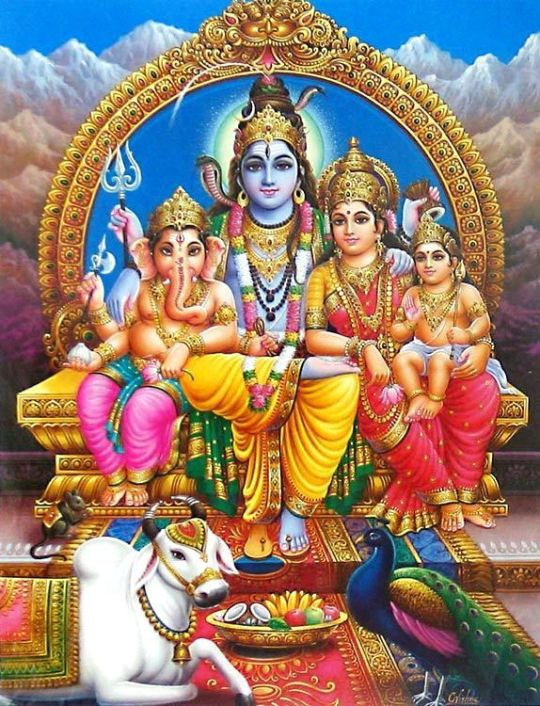
Image found on Pinterest by Dolls of India Art Store
Though there are others I hold deep veneration. The main Hindu goddess I have a connection with is Durga. She is a fierce protectress. Durga represents a female Trinity and is made up of three goddesses; Parvati, Lakshmi and Sarasvati, but has nine forms, all of which are venerated in the Hindu festival Navaratri. Navaratri venerates Durga for overcoming great trials and triumphing over evil.
The nine forms of Durga venerated on Navaratri:
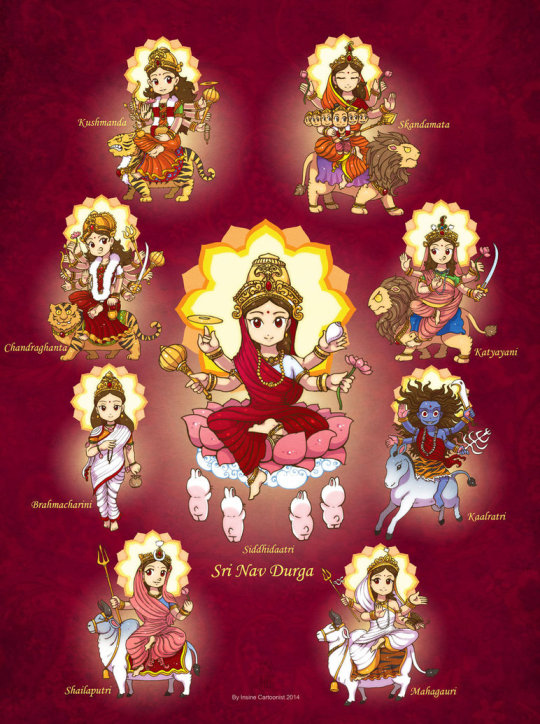
Art by: Insine Cartoonist
You will see me posting about this festival each year. This year Navaratri falls on October 3rd to the 12th, each day celebrates a different one of Durgas forms.
While I am not a Hindu, I still have great respect for this culture and find it very fascinating. I have had very amazing results by joining (in my own way) the celebrations of Navaratri. You'll likely see me posting about this later in the year. ✨🙏✨
#saganssorcery q&a#sagans sorcery#shiva#parvati#ganesha#karikeya#hindu#chaos magick#gods and goddesses#goddess durga#goddess worship#ganesh#lord ganesh#skanda#lord shiva#magick#festival#sorcery#sorceress#witchcraft#deity worship#deity work#deity
7 notes
·
View notes
Text
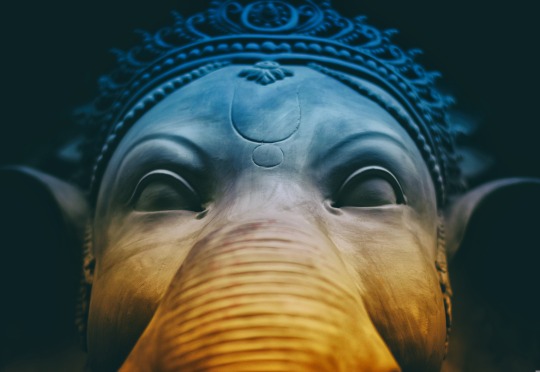
8 notes
·
View notes
Text




Unofficial commission
These is my first watercolor painting for commissioned by my mother to give away with our family. However, I will not to do open official full time commission. Because, I am not ready to can do it that, and also, I must to learn about how to do commission more.
#my art#illustrations#illustration#lord ganesh#ganesha#watercolor#hindu gods#hindu mythology#hinduism#commission#parvati#shiva#deities#deity#god#goddess#mythology
16 notes
·
View notes
Text
Lord Ganesha - A Hindu Deity
Ganesha, the beloved deity of Hinduism, holds a special place in the hearts of millions worldwide. Revered as the remover of obstacles, the patron of arts and sciences, and the harbinger of wisdom and prosperity, Ganesha embodies the essence of divine grace and benevolence. Read more at: Lord Ganesha - The God of wisdom, prosperity and good fortune | Hindu Deity


1 note
·
View note
Text

A redesign of Okina Matara, inspired by Japanese depictions of Mahakala. This isn't meant to shade anyone in particular, but there tends to be a lot of misunderstanding around the identification of Matarajin and Mahakala, and by extension how the perception of Mahakala differed in Japanese Buddhism, as opposed to say Hinduism, which I wanted to respond to with this redesign. The identification of Matarajin with Mahakala is made rather explicit in the Keiran Shūyōshū (渓嵐拾葉集; “Collection of Leaves Gathered from Stormy Streams”), compiled in the fourteenth century by the monk Kōshū (光宗), which provides a legendary account of Ennin's encounter with Matarajin at sea, alongside a secret clarification:

Important to note here though, is that Matarajin is also identified with a dakini, a kind of demonic entity that was believed to consume corpses. The reference to a dakini is far from random here, as Mahakala was characterized as a tamer of demonic forces, such as the dakinis, in East Asian Buddhism, owing to an account provided in the Darijing-shu (大日經疏; “Commentary on the Mahāvairocana Sūtra”) by Yixing:

This identity of Mahakala as a tamer of dakinis, alongside his role as a wrathful deity and protector of monasteries, underpinned their perception in Japanese Buddhism far more than their identity as a manifestation of Shiva in Hinduism. I can understand the enthusiasm of trying to link Matarajin to a big name like Shiva, but this just isn't the case, Matarajin was never linked to Shiva (or Daijizaiten for that matter), and the connection between Shiva and Mahakala was relatively unimportant in Japan. Additionally, the name Matarajin (摩多羅神) is useful to consider when understanding how Matarajin and Mahakala are connected, as it is most likely derived from Mata (摩多), which serves as a transliteration of the Sanskrit mātṛ́; “mother”, also pluralized as mātaraḥ, which in-turn refers to the matrikas. This may indicate that Matarajin was initially understood to be a deification of the matrikas as a single figure, or a title, i.e. “god of the matrikas”, referring to the deities that presided over them, such as Mahakala, Yama and Ganesha.

Much like the dakinis, the matrikas were understood in Japan as demonic entities, specifically gods of pestilence. In the context of the Matarijin-hō (摩怛利神法) ritual, which aimed to ward-off disease, the name Matarijin (摩怛哩神), which may be a variant of Matarajin, is explicitly used to refer to Mahakala in their role as a god that rules over the matrikas, also called the “seven mothers” (Shichimoten 七母天 or Shichimatari 七摩怛哩). Lending some credence to the idea that Matarajin may have initially served as a title for Mahakala, that later developed into a distinct deity.

Pictured above, a depiction of Mahakala labeled as Matarijin (摩多利神). Mahakala's iconography in Japan was rather distinct too, drawing largely from Huilin's description of the deity in the Renwang-jing (仁王經; "Humane King Sutra"):

It needs to stressed too that Matarajin wasn't simply a Japanese version of Mahakala either, it's certainly been suggested that he has is roots in Mahakala, but he evidently lost the wrathful imagery of Mahakala very early on and became a largely individualized figure. His identification with Mahakala is also informed specifically by the latter's ties to the matrikas and dakinis (which are themselves very closely related entities), and as such Matarajin can't just be treated as identical to say Daikokuten, as the latter become almost entirely detached from such demonic associations despite also being derived from Mahakala. This also brings up an important notion to consider when approaching Japanese Buddhist deities in general, that even though many have their roots in Hindu deities, they are still unique in their own respect. Daikokuten himself is emblematic of this, as his image as a squat and jovial god of fortune is about as far from the Indian Mahakala as you can get. In modern scholarship, Matarajin is also considered to belong to a class of deities called ijin (異神; "strange/alien gods") which often appear to possess foreign affinities, yet emerged exclusively within the context of Japanese Buddhism. Similar deities include the likes of Dakiniten, Sanbō Kōjin and Gozu Tennō. With that in mind, I wanted to draw specifically from the Japanese view of Mahakala, and especially depictions of Matarijin, to better reflect the reality of Matarajin's connection to Mahakala and their strange history as an ijin. Namely including the flayed elephant skin, skull garland and snakes coiled around the body.

This is a pretty cursory and rambling coverage of the subject, and I plan to eventually finish writing up a comprehensive post (or series of posts) covering Matarajin and Okina, but given its scope and my desire to focus on other projects for the time being, it will have to wait. As a whole though I would really like to push back against the idea that Matarajin's connections are somehow random, on the contrary, they tend to be pretty coherent once you understand the inherent complexity of Japanese Buddhism, and certainly aren't the result of some small cult haphazardly identifying Matarajin with any deity they felt like, as I've seen some Touhou fans claim. To this end, I think it's important to make clear the specific context in which Matarajin and Mahakala were connected, and if nothing else I think doing so at least makes for a pretty fun design.
54 notes
·
View notes
Text


The Swastika Symbol 卍 The Buddhist swastika is called "manji" (卍) in Japanese, and it is known as "wan" (卍, 万)" in Chinese. In Sanskrit, it is referred to as "svastika" (स्वस्तिक), which means "conducive to well-being," derived from "su-" (good, auspicious) and "asti" (to be, to exist).
Meaning & Symbolism in Buddhism
In Buddhist tradition, the manji (swastika) is a sacred and auspicious symbol representing harmony, eternity, and the interconnectedness of all things. Its arms, usually turning to the left (counterclockwise, 卍) in East Asian Buddhism or to the right (clockwise, 卐) in Indian traditions, symbolize the revolving forces of Dharma and the eternal cycle of life, death, and rebirth (Samsara).
Deeper Symbolism
Cosmic Harmony – It represents the balance of opposites (like yin and yang in Taoism), reflecting the unity of all phenomena. Buddha’s Heart and Footprint – In many Buddhist iconographies, the swastika is found on the chest or palms of statues of the Buddha, signifying his infinite wisdom and compassion. The Wheel of Dharma (Dharmachakra) – The swastika is a geometric simplification of the eight-spoked Dharma Wheel, showing the ever-moving cosmic order of the universe. Four Cardinal Directions – It extends to the fourfold nature of existence (North, South, East, West), linking it to space and the infinite expanse of reality.
Esoteric Buddhist Perspectives
In Vajrayāna Buddhism, the swastika often appears in mandalas and yantras as a gateway to higher consciousness. It is also associated with certain Bodhisattvas, particularly Maitreya, the future Buddha.
In Japanese Esoteric Buddhism (Shingon), the manji is a symbol of the primordial truth and the cosmic reality of Mahāvairocana Buddha (Dainichi Nyorai)��the central deity in many tantric practices.
Connection to Other Traditions
In Jainism, it represents the four states of existence: gods, humans, animals, and hell-beings. In Hinduism, it is a solar symbol linked to Surya (the Sun), Vishnu, and Ganesha. In Western Esotericism, the swastika has been used as a solar, alchemical, and Hermetic emblem, predating its later misappropriations.
The Buddhist Swastika (Manji) in Western Hermeticism and Qabalah
The manji (卍 / 卐) in Buddhist symbolism aligns deeply with principles found in Western Hermetic Qabalah, Alchemy, and Tarot, especially when understood as a rotating force of cosmic balance, evolution, and divine will.
1. The Swastika as the Rotating Cross of the Elements (Tetragrammaton & Tiphareth)
In the Western Hermetic tradition, the cross (☩) is a foundational symbol, representing the four elements, the four directions, and the divine tetragrammaton (יהוה - Yod-Heh-Vav-Heh). The swastika, being a rotating cross, adds the idea of motion, transformation, and the eternal turning of the cosmos.
Tiphareth (תפארת), the Solar Sephirah in Qabalah, aligns perfectly with the swastika’s solar connotations, particularly in Hindu and Buddhist traditions. The Golden Dawn viewed the swastika as a rotating force that could symbolize either constructive (deasil, clockwise) or destructive (widdershins, counterclockwise) currents, akin to the alchemical cycles of dissolution and coagulation.
This movement mirrors the Hermetic axiom: "As above, so below"—the continual unfolding and refolding of divine patterns in the physical world.
2. Tarot and the Breath of the Swastika (Manji)
If we think of Tarot as a breath cycle, the swastika represents the continuous inhale and exhale of divine energy through the suits and elements.
The Four Arms of the Swastika = The Four Suits of the Minor Arcana Wands (Fire) – Creative motion, the Will in action Cups (Water) – Emotional currents, the inner spiral of the soul Swords (Air) – Thought’s dynamic process, movement in mind Disks (Earth) – The physical realization of spiritual laws
Thus, the swastika aligns with The Wheel of Fortune (X) in the Major Arcana, which reflects the perpetual turning of karma, dharma, and cosmic cycles.
3. The Swastika and the Qabalistic Lightning Flash
In Hermetic Qabalah, the Lightning Flash of Creation, which descends from Kether to Malkuth (forming the path of divine emanation), has a rotational counterpart: the return ascent of consciousness—aligning with the swastika’s cyclical motion.
The descent (clockwise, 卐) aligns with the involution of divine force into matter The ascent (counterclockwise, 卍) represents spiritual return, enlightenment, and Nirvana
This matches the Buddhist idea that the swastika embodies the eternal path of awakening—a journey from illusion (Malkuth) back to divine unity (Kether).
4. Esoteric Alchemy: The Swastika as the Prima Materia
In Alchemy, the swastika symbolizes the dynamic transformation of the Prima Materia (first matter) into the Philosopher’s Stone.
The turning arms represent the alchemical process: Calcination (Fire), Dissolution (Water), Separation (Air), and Conjunction (Earth). In this sense, the manji is a glyph of transmutation—the constant reworking of base consciousness into divine gold.
This echoes Vajrayāna Buddhist teachings, which treat the mundane world as raw material for enlightenment, just as an alchemist transmutes lead into gold.
5. The Swastika as the Key to Magickal Motion (Chokmah’s Whirlwind)
Chokmah (חכמה) in Qabalah is associated with the whirlwind of divine motion—it is not static wisdom but active, living force, the archetypal "Will to Evolve."
In this sense, the swastika is a glyph of Chokmah’s energy descending into creation (Yod, the first spark) The rotation signifies the primal whirlwind, the storm of existence, which eventually crystallizes into form (Binah, structure).
Thus, the manji is a cosmic yantra of divine will in perpetual movement—never fixed, always flowing. Final Synthesis: Manji as the Breath of the Divine
The Buddhist swastika is a universal expression of the Hermetic Great Work:
1.It shows the interplay of creation and dissolution, much like the Tree of Life and the Lightning Flash. 2.It is a breath—inhale (form), exhale (transformation)—mirroring the cycle of Tarot and Qabalah. 3.It represents the eternal journey of the soul, the Wheel of Fortune turning through Samsara toward ultimate enlightenment. -Tarot of Eli
65 notes
·
View notes
Note
Like yessss she couldn't be more wrong
She'll die when she meets Vasant and Vishnu. Like gurl Indians ain't about dat toxic masculinity shit here 🗿💅
Hera: *seeing all the twinkest Hindu Gods* Oh brother-
Poseidon: Yes?
Hera: NOT YOU POSEY.
Poseidon: Damn gurl you look mad 🗿
Hera: NO SHIT. I THOUGHT INDIANS WERE BETTER THAN DIO.
Vishnu: Bestie open up your minddd. Look how your stepson is slaying that look....... And our army GUYS WE GOTTA DO SOMETHING-
And YESSS like I said she and Shachi are canon for me 💅. But yes she'd also love Kali HEHEH
In Dionysiaca Hera is constantly going "Dio is so effeminate look as these MASCULINE Indians they're better than you" and shii and I'm like bestie ☠️ You haven't met their Gods bestie ☠️ Bestie our cultures are sisters from a common parent bestie ☠️ They both got twink gods bestie ☠️
Honestly 💀 I lowkey want her to meet the twink-est Gods from the Hindu pantheon like- Vishnu, Mitra, Soma and so on... Like...
Let gurl have the realisation!!!! Everyone's a twink and that's what they should be 😌
And I also want her to meet ALL the Goddesses like- I want her to be in awe of them- especially Parvati and Ganesh ahem ahem... So yeah... But also Kali and other's like-
#hera#hera greek mythology#greek mythology#dionysus#vishnu#chandra#mitra#parvati#ganesha#kali#desiblr#desi tumblr#hindu mythology#hindu gods#desi tag#desi shit posting#desi#hindu deities#greek deities#poseidon#dionysos#shachi
27 notes
·
View notes
Photo
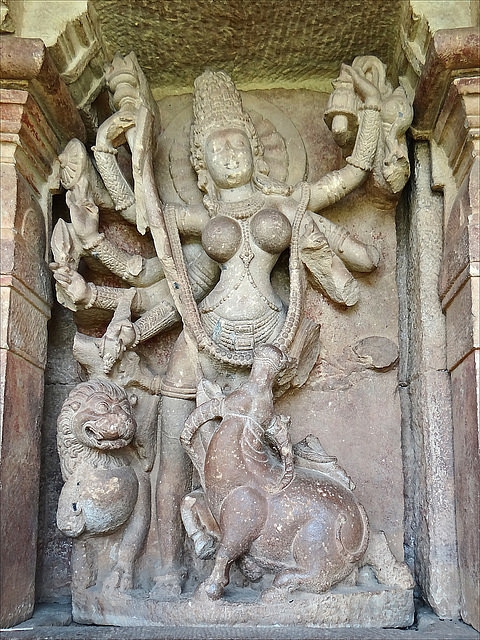
Devi
Devi, also known as Mahadevi or 'Great Goddess', is an all-embracing Mother Goddess first worshipped in India in Prehistoric times. In the Vedic period, she was assimilated into the Hindu pantheon and so came to represent the female energy or Sakti (Power) of her husband Shiva. Both Devi (meaning goddess in Sanskrit) and Sakti may also be used more generically to reference any female Hindu goddess, especially Parvati, Lakshmi, and Sarasvati. Devi is most often manifested as the fearsome female warriors Durga and Kali, both of whom famously killed a number of terrible demons in Hindu mythology. Devi is also the mother of Nandi, Shiva's doorkeeper and bull; Skanda, the six-headed god; and Ganesha, the elephant-headed god.
Devi's character has two opposing sides represented by various separate female deities: as Uma, the benevolent, and as Durga, the terrible. It is as the latter, more fierce personification that she is most frequently worshipped. Her dark side can also take the form of the fearsome black goddess Kali. The deity has a myriad of many other names and may, for example, also be referred to as Vindhyavasini, Kanya (the Virgin), Mahamaya (the Illusion), and Bhutanayaki, the queen of the Bhuta, those ghosts and goblins who haunt graveyards, make the dead live again, and trick the living so that they might feast on their flesh.
The Two Sides of Devi: Uma & Durga
Devi's more benevolent side is worshipped as Uma, and this facet of her character is represented as both beauty and light. This softer side is also referred to as Jaganmata (Mother of the World), Gauri (Yellow and Brilliant or Golden), Bhavani, Haimvati, and Parvati (the Mountaineer).
Devi's dark side is represented as the terrible Durga (the Inaccessible) who has ten arms, an impressive armoury of weapons, and who rides a magnificent lion or tiger. This side is further manifested in the forms of Kali, Kalika or Syama (the Black Goddess); Candi or Candika (the Fierce), in which guise she killed many a demon or asura; and Bhairavi (the Terrible). Worshippers of this face of Devi seek her favours and dark powers and so make blood sacrifices and perform wild rituals in the ceremonies of Durga-puja, Carak-puja, and the Tantrikas which call on Durga's sexual and magical powers.
Continue reading...
81 notes
·
View notes
Text




[Unofficial Commission] Siddhi Ganapati
Hiya, everyone! It's me.
This is my first time with my invisible ink that I think, ppl can see this without use UV black light. LOL. Thus, I think, I should be add more water.
And after I did make ink, I'm under in the weather by chemical effect. So, I just make ink by put water and gum arabic only in the next time. I hope, I will get well soon. 🥹
My music that I played to listen while I'm painting this:
youtube
#my art#preawprawchanart#illustrations#art#illustration#watercolour#commission#lord ganesha#hindu deities#Youtube
3 notes
·
View notes
Text

Today's Guidance from The Multi-Dimensional Oracle 🌌
Ganesha 🐘👑
✨️✨️🩵
Beginnings, Clearing obstacles, Intellect, Acceptance
🪷
"Ganesha is a prominent Hindu deity, revered as the "Lord of Beginnings" and "Remover of Obstacles". He is known for his elephant head and is widely worshipped before starting new ventures to ensure success and smooth progress. Ganesha is also associated with wisdom and knowledge." (Google)
Pentacles a Rose the cards and Winter Oracle Readings
15 notes
·
View notes
Text
Lord Ganesha | Remover of Obstacles


Lord Ganesha, also known as Ganapati, Vinayaka, or Pillaiyar, is one of the most revered deities in Hinduism. Recognizable by his elephant head, Ganesha is worshipped as the remover of obstacles, the patron of arts and sciences, and the deva of intellect and wisdom. His presence is invoked before the beginning of any new venture or journey, symbolizing auspicious beginnings and successful outcomes. Ganesha's origins, characteristics, and the rich tapestry of stories associated with him provide profound insights into Hindu philosophy and culture.
Birth and Origins
Ganesha's birth is narrated in various scriptures, most notably the Shiva Purana and the Skanda Purana. According to these texts, Ganesha was created by Goddess Parvati, the consort of Lord Shiva, from the turmeric paste she used for her bath. Parvati fashioned a boy from this paste and breathed life into him. She then set him at the entrance of her abode to guard it while she bathed. When Shiva returned and attempted to enter, Ganesha, unaware of who Shiva was, stopped him. In the ensuing conflict, Shiva, in a fit of rage, severed Ganesha's head. To console the grief-stricken Parvati, Shiva promised to bring Ganesha back to life. He instructed his followers to find the head of the first living being they encountered, which happened to be an elephant. Shiva placed the elephant's head on Ganesha's body, reviving him and blessing him to be worshipped before all other deities.
Characteristics and Symbolism
Physical Appearance
Ganesha's distinctive elephant head symbolizes wisdom, understanding, and a discriminating intellect that one must possess to attain perfection in life. His large ears signify that a perfect person is the one who possesses a great capacity to listen to others, and his small mouth suggests he talks less and listens more. The trunk of Ganesha is capable of holding a lotus or a modak (a sweet) and symbolizes high adaptability and efficiency.
Attributes
Large Head: Represents wisdom and knowledge.
Small Eyes: Denote concentration and focus.
Trunk: Indicates adaptability and strength.
Big Ears: Symbolize a keen ability to listen and absorb ideas.
Small Mouth: Emphasizes the importance of speaking less.
One Broken Tusk: Signifies the acceptance of the good and the bad in the world.
Iconography
Ganesha is often depicted with a potbelly, symbolizing the capacity to digest both good and bad experiences. He usually holds an axe (to cut off bonds of attachment), a rope (to pull devotees closer to their highest goal), and a modak (representing the sweetness of the soul). His vehicle, the mouse, symbolizes humility and the ability to overcome desires.
Personality and Traits
Ganesha is known for his intellect, wisdom, and benevolence. He is also celebrated for his humor and playfulness, which are evident in numerous stories about him. Despite his divine status, Ganesha is approachable and understanding, making him beloved among devotees. His ability to solve problems and remove obstacles makes him a popular figure for those seeking guidance and support in their endeavors.
Family
Ganesha is part of the Shaivite tradition and is closely associated with his parents, Lord Shiva and Goddess Parvati. His brother is Kartikeya, also known as Murugan, who is the god of war. The familial relationships and stories involving these deities highlight the dynamics of divine interaction and provide moral and spiritual lessons.
Parents: Shiva and Parvati
Shiva, the destroyer in the Hindu trinity, represents the aspect of God that brings about transformation and change, while Parvati represents love, fertility, and devotion. Their union symbolizes the balance of male and female energies in the universe.
Brother: Kartikeya
Kartikeya, also known as Skanda or Murugan, is a warrior deity. The sibling rivalry and companionship between Ganesha and Kartikeya are depicted in various myths, emphasizing different aspects of duty, strength, and wisdom.
Popular Stories
Ganesha and the Mango
One of the well-known stories of Ganesha is the competition between him and Kartikeya to win a mango, a fruit of immortality and wisdom. Shiva and Parvati decided that the one who could circle the world three times first would win the mango. Kartikeya immediately set off on his peacock, but Ganesha, knowing he couldn't match his brother's speed, simply circled his parents three times, stating that for him, they were his world. Pleased by his wisdom, Shiva and Parvati gave him the mango.
The Writing of the Mahabharata
Another significant tale is Ganesha's role as the scribe of the Mahabharata. Sage Vyasa sought someone who could transcribe the epic as he recited it. Ganesha agreed to take on the task on the condition that Vyasa would recite it without pause. To ensure that Ganesha would write carefully, Vyasa composed the verses in a complex meter, which required Ganesha to pause occasionally to understand them, giving Vyasa time to compose further.
Association with Astrology
In Vedic astrology, Ganesha is associated with the planet Ketu. Ketu represents obstacles, detachments, and spiritual pursuits, qualities that align with Ganesha’s role in removing obstacles and guiding devotees on the path of wisdom and spirituality. Devotees often invoke Ganesha’s blessings to mitigate the malefic effects of Ketu in their astrological charts.
#vedic astrology#astrology#sidereal astrology#nakshatra#sidereal#vedic#jyotish#desi#hinduism#ganesha#hindu mythology#ketu
52 notes
·
View notes